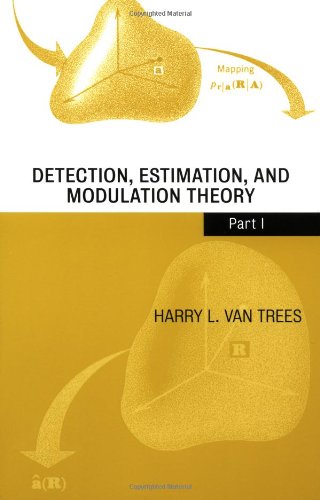

Most ebook files are in PDF format, so you can easily read them using various software such as Foxit Reader or directly on the Google Chrome browser.
Some ebook files are released by publishers in other formats such as .awz, .mobi, .epub, .fb2, etc. You may need to install specific software to read these formats on mobile/PC, such as Calibre.
Please read the tutorial at this link. https://ebooknice.com/page/post?id=faq
We offer FREE conversion to the popular formats you request; however, this may take some time. Therefore, right after payment, please email us, and we will try to provide the service as quickly as possible.
For some exceptional file formats or broken links (if any), please refrain from opening any disputes. Instead, email us first, and we will try to assist within a maximum of 6 hours.
EbookNice Team

Status:
Available5.0
40 reviews
ISBN-10 : 0471095176
ISBN-13 : 9780471095170
Author: Harry L. Van Trees
Highly readable paperback reprint of one of the great time-tested classics in the field of signal processing Together with the reprint of Part III and the new Part IV, this will be the most complete treatment of the subject available As imperative today as it was when it originally published Has important applications in radar, sonar, communications, seismology, biomedical engineering, and astronomy Includes section summaries, examples, and a large number of problems
1 Introduction
1.1 Topical Outline
1.2 Possible Approaches
1.3 Organization
2 Classical Detection and Estimation Theory
2.1 Introduction
2.2 Simple Binary Hypothesis Tests
Decision Criteria
Performance: Receiver Operating Characteristic
2.3 M Hypotheses
2.4 Estimation Theory
Random Parameters: Bayes Estimation
Real (Nonrandom) Parameter Estimation
Multiple Parameter Estimation
Summary of Estimation Theory
2.5 Composite Hypotheses
2.6 The General Gaussian Problem
Equal Covariance Matrices
Equal Mean Vectors
Summary
2.7 Performance Bounds and Approximations
2.8 Summary
2.9 Problems
References
3 Representations of Random Processes
3.1 Introduction
3.2 Deterministic Functions: Orthogonal Representations
3.3 Random Process Characterization
Random Processes: Conventional Characterizations
Series Representation of Sample Functions of Random Processes
Gaussian Processes
3.4 Homogeneous Integral Equations and Eigenfunctions
Rational Spectra
Bandlimited Spectra
Nonstationary Processes
White Noise Processes
The Optimum Linear Filter
Properties of Eigenfunctions and Eigenvalues
3.5 Periodic Processes
3.6 Infinite Time Interval: Spectral Decomposition
Spectral Decomposition
An Application of Spectral Decomposition: MAP Estimation of a Gaussian Process
3.7 Vector Random Processes
3.8 Summary
3.9 Problems
References
4 Detection of Signals–Estimation of Signal Parameters
4.1 Introduction
Models
Format
4.2 Detection and Estimation in White Gaussian Noise
Detection of Signals in Additive White Gaussian Noise
Linear Estimation
Nonlinear Estimation
Summary : Known Signals in White Gaussian Noise
4.3 Detection and Estimation in Nonwhite Gaussian Noise
"Whitening" Approach
A Direct Derivation Using the Karhunen-Loeve Expansion
A Direct Derivation with a Sufficient Statistic
Detection Performance
Estimation
Solution Techniques for Integral Equations
Sensitivity
Known Linear Channels
4.4 Signals with Unwanted Parameters: The Composite Hypothesis Problem
Random Phase Angles
Random Amplitude and Phase
4.5 Multiple Channels
Formulation
Application
4.6 Multiple Parameter Estimation
Additive White Gaussian Noise Channel
Extensions
4.7 Summary and Omissions
Summary
Topics Omitted
4.8 Problems
References
5 Estimation of Continuous Waveforms
5.1 Introduction
5.2 Derivation of Estimator Equations
No-Memory Modulation Systems
Modulation Systems with Memory
5.3 A Lower Bound on the Mean-Square Estimation Error
5.4 Multidimensional Waveform Estimation
Examples of Multidimensional Problems
Problem Formulation
Derivation of Estimator Equations
Lower Bound on the Error Matrix
Colored Noise Estimation
5.5 Nonrandom Waveform Estimation
5.6 Summary
5.7 Problems
References
6 Linear Estimation
6.1 Properties of Optimum Processors
6.2 Realizable Linear Filters: Stationary Processes, Infinite Past: Wiener Filters
Solution of Wiener-Hopf Equation
Errors in Optimum Systems
Unrealizable Filters
Closed-Form Error Expressions
Optimum Feedback Systems
Comments
6.3 Kalman-Bucy Filters
Differential Equation Representation of Linear Systems and Random Process Generation
Derivation of Estimator Equations
Applications
Generalizations
6.4 Linear Modulation: Communications Context
DSB-AM: Realizable Demodulation
DSB-AM: Demodulation with Delay
Amplitude Modulation: Generalized Carriers
Amplitude Modulation: Single-Sideband Suppressed-Carrier
6.5 The Fundamental Role of the Optimum Linear Filter
6.6 Comments
6.7 Problems
References
7 Discussion
7.1 Summary
7.2 Preview of Part II
7.3 Unexplored Issues
References
detection estimation and modulation theory pdf
detection estimation and modulation theory part 1 pdf
detection estimation and modulation theory part 1
detection estimation and modulation theory part ii pdf
detection estimation and modulation theory part ii
Tags: Detection, Estimation, Modulation Theory, Harry Van Trees